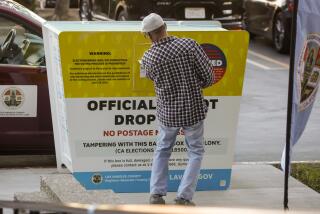Parsing the early vote: Who’s winning?

With more than 27 million Americans having already voted, the Obama and Romney campaigns have found a new topic for disagreement: what do the numbers say about who is winning?
In a conference call with reporters Saturday, top officials of President Obama’s campaign insisted that they were building a lead in key states that Romney would have difficulty overcoming.
“Our opponent is losing among early voters in nearly every public poll in every battleground state,” Jeremy Bird, the campaign’s field director, told reporters in a late-afternoon conference call. Romney would have to win the election day vote with majorities as large as 60% in some states in order to prevail, he said, citing polling figures.
ELECTION NIGHT COVERAGE: Ask the Times
Republican officials countered that Obama’s margins had fallen below those that he achieved in 2008, suggesting that made the president vulnerable to an election day push by the GOP.
The two sides also disagree over whether Obama’s early-vote efforts have succeeded in turning out sporadic voters – those who only show up for some elections – or whether the campaign has simply drained the pool of available Democratic voters early.
Democrats insist the information they have gathered through voter contacts makes them confident that they are getting the sporadic voters they have targeted. In a memo to reporters, Republican officials contended that the Obama campaign was “cannibalizing” voters who would otherwise have voted Tuesday.
Neither side can be sure of its numbers, of course – the early votes have been cast, but won’t be counted until Tuesday. Instead, the campaigns draw inferences from the party registration those who have voted early and other information they have about the voters who have gone to the polls.
In some states, the statistical picture seems fairly clear. In Nevada, for example, where early voting finished Friday, Democrats have a formidable lead, solidifying the forecasts from polls that have suggested Nevada will wind up in the president’s column.
Registered Democrats outnumbered registered Republicans by almost 48,000 ballots out of more than 700,000 cast in the state, according to figures released Saturday by the Nevada secretary of state’s office. The early vote amounted to 56% of the registered voters statewide, which is up from 2008. Since not all registered voters will cast a ballot, the numbers suggest that about two-thirds of the Nevada vote is already over.
To win the state, Mitt Romney would have to rack up a large majority among the early voters who were not registered in either party (19% of the early turnout) and win heavily on election day – a tall order.
INTERACTIVE: Predict a winner in the battleground states
The Democratic margin is smaller, but still formidable in Iowa, where about 614,000 people have voted, according to state statistics compiled by George Mason University political scientist Michael McDonald. Iowa Democrats lead Republicans among the early voters by an 11-point margin, 43% to 32%.
The picture seems more favorable to the Republicans in Colorado, where early voting also ended Friday and where almost 80% of the vote in 2008 was cast early. Republicans hold a small advantage in party registration among early voters so far -- 36.9% to 34.6%. Four years ago, it was the Democrats who held a small margin among early voters. The flip is a good sign for Republicans; on the other hand, Obama won the state in 2008 by 9 percentage points over Sen. John McCain, giving him a substantial cushion.
With so much of the state’s vote being cast by independents, the deciding question will be which candidate wins among them. Democrats point to big increases in turnout among Latinos in Colorado, many of whom register as independents, and say that bodes well for them.
The results are more ambiguous in the country’s two-biggest early-voting swing states, Florida and Ohio.
Florida, the nation’s biggest swing-vote prize, wraps up its early voting Saturday night. As of midday, with about 4 million of the state’s voters having cast ballots, registered Democrats had built up a margin of more than 100,000 votes over registered Republicans.
That’s a considerably smaller margin than in 2008 – and also a smaller absolute number, reflecting the fact that the state has fewer days of early voting this year. In 2008, McCain won the voters who showed up on election day in Florida. Republicans say Romney will repeat that and carry the state, which is a must-win for him.
Democratic officials say their get-out-the-vote operation will carry Obama over the top in the state. Polls in Florida have varied widely, in part because of the difficulty of predicting who is a “likely voter” in a state where the voter population changes so much from election to election. Political strategists on both sides say the state appears to be a dead heat.
Ohio does not register voters by party. Instead, the state classifies voters according to the primary in which they most recently voted. Anyone who didn’t vote in the most recent primary is listed as a non-party voter. That makes interpreting the state’s early vote numbers difficult. About 1.3 million Ohioans had voted by Saturday. Obama campaign officials say they have established a strong lead over Republicans in turning out the targeted sporadic voters they’ve been seeking. Perhaps more important an indicator, Obama has consistently led in public polls of the state’s likely voters.
Follow Politics Now on Twitter and Facebook
Twitter: @DavidLauter
More to Read
Get the L.A. Times Politics newsletter
Deeply reported insights into legislation, politics and policy from Sacramento, Washington and beyond. In your inbox three times per week.
You may occasionally receive promotional content from the Los Angeles Times.







